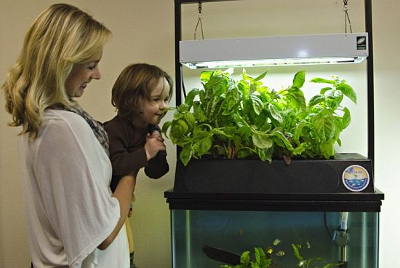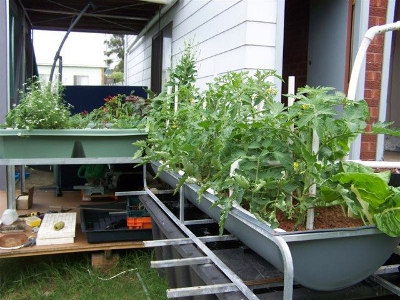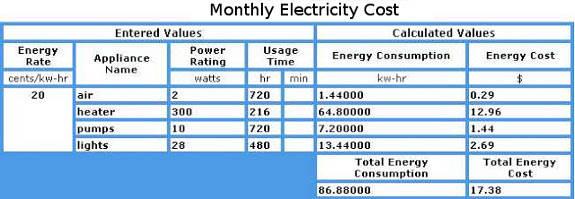
Disadvantages of aquaponics
If aquaponics
is such an elegant, created ecosystem, why am I down on it?
Simple --- electricity use.
 First, there's the pump (or
pumps) used to push water out of the fish tank and into the grow
beds. Next comes the energy used to heat the water --- to ensure
the bacteria and worms stay active enough to convert fish waste into
nitrates, most people keep their aquaponics systems running at or above
room temperature summer and winter. And then there are the grow
lights since many people run aquaponics systems inside to get more
control over the environment. To be honest, once you pour all
that electricity into the system, I'm not so sure aquaponics is any
better for the earth than mainstream agriculture.
First, there's the pump (or
pumps) used to push water out of the fish tank and into the grow
beds. Next comes the energy used to heat the water --- to ensure
the bacteria and worms stay active enough to convert fish waste into
nitrates, most people keep their aquaponics systems running at or above
room temperature summer and winter. And then there are the grow
lights since many people run aquaponics systems inside to get more
control over the environment. To be honest, once you pour all
that electricity into the system, I'm not so sure aquaponics is any
better for the earth than mainstream agriculture.
Next, there's the fish
food to consider. Although aquaponics looks like a closed loop,
it really isn't --- nearly everyone just buys large quantities of
commercial fish food to nourish their tilapia or goldfish.
Granted, fish are more efficient at converting feed to meat than other
forms of livestock, but you're still basically running a fish CAFO (and
contributing to overfishing since most fish feed contains wild-caught
fish meal.)
 Aquaponics arose in
Australia, and there it makes much more sense. Throughout most of
their continent, Australians experience moderate-enough winter
temperatures that they don't need to bring their aquaponics systems
indoors. And rain is scarce enough that minimizing water use may
trump minimizing electricity consumption. Aquaponics also has
potential in other subtropical and tropical climates, especially in
cities where good soil is scarce.
Aquaponics arose in
Australia, and there it makes much more sense. Throughout most of
their continent, Australians experience moderate-enough winter
temperatures that they don't need to bring their aquaponics systems
indoors. And rain is scarce enough that minimizing water use may
trump minimizing electricity consumption. Aquaponics also has
potential in other subtropical and tropical climates, especially in
cities where good soil is scarce.
The other place where
aquaponics shines is if you consider it a way of growing high-density
fish with the plants just being a side note. Wild-caught fish and
factory-farmed fish both have environmental problems attached, so it
makes sense to try to come up with a more sustainable solution.
That assumes, of course, that you actually eat the fish in your
aquaponics setup, unlike the author of Aquaponic
Gardening who came
to regard her tilapia as pets.
| This post is part of our Aquaponic Gardening lunchtime series.
Read all of the entries: |
Want more in-depth information? Browse through our books.
Or explore more posts by date or by subject.
About us: Anna Hess and Mark Hamilton spent over a decade living self-sufficiently in the mountains of Virginia before moving north to start over from scratch in the foothills of Ohio. They've experimented with permaculture, no-till gardening, trailersteading, home-based microbusinesses and much more, writing about their adventures in both blogs and books.
Want to be notified when new comments are posted on this page? Click on the RSS button after you add a comment to subscribe to the comment feed, or simply check the box beside "email replies to me" while writing your comment.


Hi Anna,
I suppose you wouldn't call what Sepp is doing aquaponics?
But it is something you could do ?
Maybe a little bit in the future. But it impresses me as a way to use water flow to grow lots of stuff in a permanent sort of way including plants and animals and fish.
I do question making it a recirculating system as some have done.
John
You're tough to fool, Anna. And I bet you don't think the Elephant Man looks anything like an elephant either.
I've always questioned the advantage of aquaponics too: it requires more fresh water (possibly the least available limiting resource overall in food production) than planting in the ground and tanks take up space over the soil anyways, so you're not saving acreage.
We have an aquaponics system that doesn't use any of these electrical components except a pump. the pump takes the water from the pond into the grow beds, and automatic siphons pull it down a waterfall back into the pond on a 20 minute cycle. the pump costs less to run in a month than a light bulb. we don't heat the water; in zone 7, there's no need. and as the system is outdoors, there are no lights involved. we do feed the fish, as we are still getting the system going, so there's a small fish-food cost, but that's very minor. our AP system is designed to produce fresh greens for our table, as well as fresh fish; both are a primary goal. (we're getting bluegill, though, not tilapia; they are native and taste better.)
Here's our system: http://sunflowerriver.org/blog/overview-of-the-pond-our-aquaponics-system/
That bottom photo is the backyard of a local bloke I know, here in Australia! In fact, looking at the photo closer, I actually took it! It looks like you got it from somewhere else, but I'm totally fine with you using it Anna. How weird is it that my photo would unknowingly show up on a friend's blog!?
Check out my page here for more photos of John's setup: http://green-change.com/2009/03/31/backyard-aquaponics-in-gerringong/
My biggest issue with aquaponics is that the systems don't seem to be terribly resilient. Things like water quality issues (pH, salinity, temperature), power outages, mechanical failures, fish diseases, etc can quickly wipe out the system. It's fine as a hobby, but it's not for everyone. I do think that it could work really well on a commercial scale, though, as long as the energy costs aren't too great.
@doc: Aquaponics actually uses a lot less water than planting in the ground - your only water losses are from transpiration and evaporation (plus what's stored in the plants as they grow, I guess). The water is just circulating around and around. Also it can be more space-efficient, since you can stack the grow beds on top of the fish tanks. You can also pack the plants closer than traditional in-ground methods (a bit like square foot gardening), since they aren't competing for water and nutrients.
To be honest, I think you may need to do a little more research on your facts of aquaponics. First off, Australia isn't the origin of aquaponics, as its roots are deeply tied into Egyptian history, as well as in Mayan culture. Sure, the Australians took to the idea quickly, and have provided some of the advances in the modern framework, but by no means are they the inventors.
Secondly, most aquaponists who have thought critically, and evaluated the qualities of various protein and food sources realize very quickly that a food source founded on kelp or algae, or plant products will realize nutritional qualities in their aquaculture equal to and greater than wild stocks of fish.
Finally, as the energy industry continues to make breakthroughs in efficiency, and aquaponic entreprenuers continue to find ways to limit, if not eliminate their external energy costs by using creativity and ingenuity to drive their success the science behind the system has become the main focus.
The only negative behind aquaponics I can see is that smart people and the uninformed tend to run headlong into aquaponics without allowing the time to research how complex it actually is, even though the idea is fairly simple.
Finally, in all of the systems I have seen from hobbyists to commercial scale farms, the pump system consists of one pump from the low point in the system back up to the high elevation point. No one pumps from fish tank to grow bed, to fish tank o grow bed, and running a single pump using alternative power supply is extremely efficient.
While these are only a few of my disagreements with your evaluation of aquaponics, I will provide a few of my ideas behind why aquaponics is an extremely more effective system than traditional soil based agriculture.
Soil based agriculture will become an antique of the produce market as long as aquaponics and energy industry continue to evolve at their current rate.
To the comments of wheher It appears likely you are correct with the observations about the article The author clearly seems not to have the facts straight Nor the correct conclusions As energy prices soar,pollutants continue to foul air and water Aquaponics will be the answer to sustainable fish stocks. Fresh fish from the farm for the family of the future!